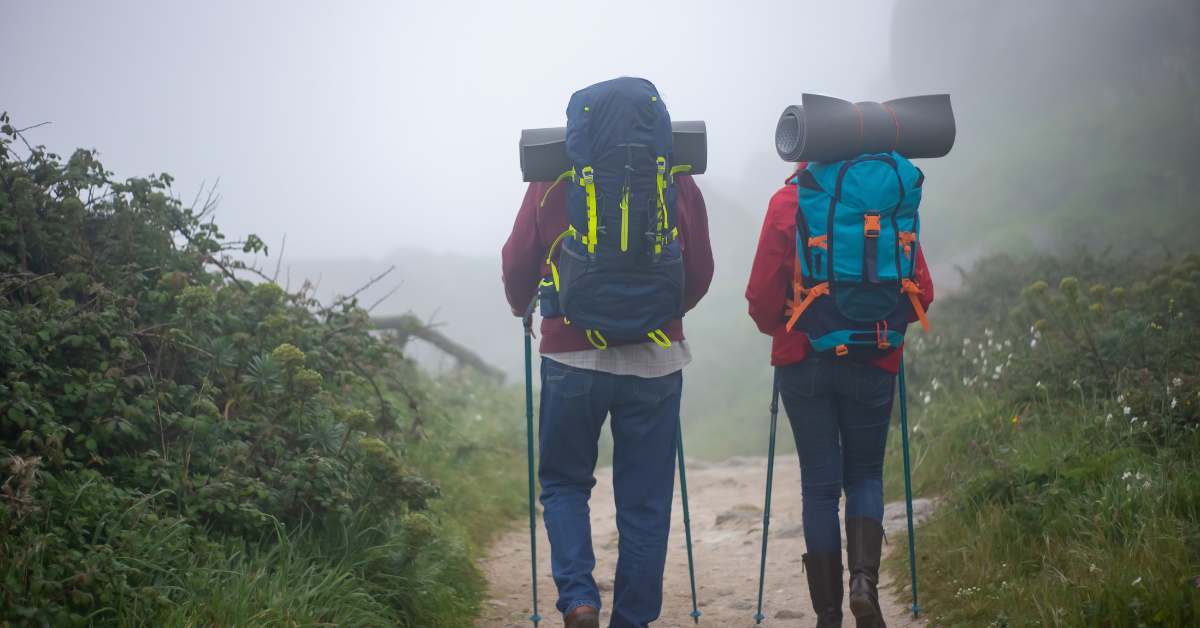The mighty Himalayas have always attracted adventurous people with their snow-covered tops, gleaming ice fields, and stunning panoramas. If you are an adrenaline junkie looking for a life-changing experience, these top 8 treks in the Himalayan region are what you need. These walks range from difficult high-altitude climbs to easy strolls through meadows, so anyone can find something suitable for their fitness level. So lace up those boots, pack that rucksack, and get ready to travel through the roof of the world on this amazing journey.
List of the 8 Best Himalayan Treks for Adventure Lovers and Enthusiasts
Here we are listing the 8 best Himalayan treks not to miss at any cost if you love trekking and seek adventure in your life.
Chadar Trek
- Difficulty Level: Challenging
- Duration: 8–10 days Best Time: January-February
If you want an absolutely unique and thrilling experience during your lifetime, put the Chadar Trek at the very top of your list. This frozen river trek takes place along the frozen Zanskar River deep inside the remote Zanskar Valley in Ladakh, India, where temperatures drop as low as minus 30 degrees Celsius or more! Imagine walking on thick sheets of ice surrounded by towering cliffs and waterfalls that have turned into icicles. The route is not for faint-hearted individuals since they will encounter subzero temperature zones, which could cause slippery trails due to melting snow, but also because there is always danger; one wrong step may mean death when thin layers of frozen rivers break underfoot. However, those who dare take up such challenges are greatly rewarded: breath-taking views await them behind every bend, together with untouched villages inhabited by few people!
Stok Kangri Trek
- Difficulty Level: Challenging
- Duration: 10–12 days Best Time: July-September
The Stok Kangri Trek is a high-altitude adventure that leads trekkers up beyond six thousand metres above sea level (6153 m), making it one of various such kinds available within the Ladakh region itself. You can see Karakoram ranges stretching far away across Zanskar valleys while standing atop the summit at this peak; moreover, Ganda La pass provides the best opportunity ever possible for taking photographs showing off surrounding peaks like Nun Kun massif, consisting mainly of Nanga Parbat (8126 m), Kang Yatse (6400 m), and Pinnacle Peak (6930 m).
Goechala Trek
- Difficulty Level: Moderate to Challenging
- Duration: 10–12 days Best Time: April–May, October–November
Goechala Trek in Sikkim offers some superb close-up views over the mighty Kanchenjunga, which is the third-highest mountain on earth. The trek takes you through dense rhododendron forests, pristine meadows, and crystal-clear lakes before reaching Goechala Pass, located at 5000 metres high above sea level (5002 m). This pass itself provides unparalleled panoramas, including the whole Kanchenjunga massif together with other peaks surrounding it, such as Pandim (6691 m). However, being one of those most challenging treks due to its extreme altitude gains combined with the very steep slopes encountered along the route, nothing beats having the opportunity to witness the beauty of these mountains from their base campsites or during actual climbing attempts themselves.
Roopkund Trek
- Difficulty Level: Challenging
- Duration: 8–9 days Best Time: May-June, September-October
Roopkund Trek is a fascinating journey, not only because of the beautiful scenery but also because of the mystery behind Skeleton Lake. The trail leads towards Roop Kund, called so after the discovery of hundreds of human corpses belonging to the 9th century AD scattered all over the bottom lake bed; hence, sometimes referred to as “Skeleton Lake.” On the way there, through thick forests, there are glacier crossings followed by panoramic views seen from Trishul, Nanda Ghunti, and Chaukhamba peaks. Though considered a strenuous affair mainly characterised by high altitudes reached coupled with steep ascents involved, nevertheless, a sense adventure attached to this place cannot be compared to any other.
Valley of Flowers Trek
- Difficulty Level: Moderate
- Duration: 6-7 days Best Time: July-August
The Valley of Flowers Trek can be considered a heaven for nature enthusiasts because it is full of colourful alpine flora and beautiful mountainous landscapes. It is situated in the Garhwal Himalayas of Uttarakhand and is recognised as a UNESCO World Heritage Site. The area is covered with vast meadows that turn into a vibrant paradise during the summer season. En route, one passes through dense forests, beside babbling brooks, and up to Hemkund Sahib, a stunning Sikh pilgrimage site known for its breathtaking beauty that leaves trekkers awe-struck every time they visit it. Although moderate in difficulty level, people are captivated by these picturesque sceneries and diverse wildlife species that can only be witnessed here.
Markha Valley Trek
- Difficulty Level: Moderate
- Duration: 6-7 days Best Time: June-September
The Markha Valley Trek is among the best-known treks in the Ladakh region because it combines fantastic landscapes with cultural interactions. This trek takes you across remote parts of Markha Valley, where you will get to see ancient Buddhist monasteries as well as traditional Ladakhi villages inhabited by friendly locals who always give a warm welcome to visitors passing through their villages. The trail meanders through dry mountains and green valleys fed by crystal-clear waters from melting snow and offers panoramic views over the Stok and Zanskar ranges, among others like them too, creating an adventure worth experiencing! Its moderate difficulty level combined with the opportunity for cultural immersion make this trek ideal either for adventure lovers or people interested in learning about different cultures.
Hampta Pass Trek
- Difficulty Level: Moderate to Challenging
- Duration: 5–6 days Best Time: June-September
Hampta Pass Trek ranks high on the diversity scale when it comes to trekking destinations within Himachal Pradesh’s Pir Panjal range. This walk leads through rich grasslands dotted with wildflowers, crosses glacier-fed streams, and tops out at the famous Hampta Pass (4270 m). Along this path, one comes across scenic spots like Indrasan Glacier, Deo Tibba Peak, Chandratal Lake, and many other beautiful places that can be seen only while undertaking such trips. It has sections that are considerably more challenging than others, thus making it suitable even for newbies who have never trekked before, provided they put some effort into training themselves physically beforehand. The satisfaction derived from conquering Hampta Pass is beyond words.
Kedarkantha Trek
- Difficulty Level: Moderate
- Duration: 5–6 days Best Time: December-April
Kedarkantha Trek serves as an excellent starting point for higher climbs within the Uttarakhand region since it offers panoramic views stretching across different Himalayan ranges once you reach its summit. Passing through serene pine forests and snow-covered meadows, then finally arriving at Kedarkantha Peak (3850 m), where one gets greeted by breathtaking vistas over various parts of this mountain range, is something that should not be missed. It’s a moderately difficult trek, which makes sense, especially if one wants to feel the excitement associated with hiking up mountains but does not desire to undergo the extreme challenges posed by such activities. These winter months create perfect conditions for beginners too, when everything turns into a wonderland under a thick layer of snow.
Tips While Going on a Trek in the Himalayan Region
Trekking in the Himalayas is a unique experience that calls for appropriate preparedness and precautions. In this regard, here are some indispensable tips to ensure a safe and joyful trip:
Physical Preparedness
One needs to be in reasonably good health while going through the Himalayas. Therefore, involve yourself in regular aerobic activities such as hiking, jogging, or cycling, which will help build your stamina. It may also be necessary for you to do strength training so that carrying your backpack becomes easier.
Acclimatisation
Altitude sickness can affect anyone at any time during their stay in the mountains. It is particularly dangerous in this area. The only solution is to ascend slowly and let your body get used to lower levels of oxygen gradually by itself. Keep drinking water frequently as well as watching out for symptoms like headaches, nausea, or fatigue.
Equipment and Clothing
Invest in high-quality lightweight and breathable trekking gear; layering is important when regulating body heat; have warm insulated jackets, waterproof outer layers (trousers too), strong trekking shoes and boots, plus sunglasses with hats and gloves, among other accessories.
Employ Experienced Guides
For difficult treks or places that are hard-to-reach, it is advisable to employ experienced guides from the locality who understand these terrains best and can guarantee safety throughout such journeys, besides sharing cultural insights about various communities living around there.
Stay Hydrated and Recharged
Trekking within the Himalayas tends to be energy-sapping; hence, one should pack high-energy snacks, e.g., energy bars, mixed nuts, dried fruits, etcetera. Do not forget to drink lots of fluids, including electrolyte-rich drinks, so as not to suffer dehydration.
Respect Environment
The Himalayan region has delicate ecosystems; therefore, while trekking, always ensure that you observe responsible tourism principles based on “Leave No Trace.” Carry reusable water bottles; avoid littering around trails. Take with you all garbage produced during the journey. Respect local customs and traditions.
Be Ready for Emergencies
Remember to put together a well-stocked first aid kit, including medicines for altitude sickness, and don’t forget about travel insurance. Always leave behind someone informed of your plans concerning trekking as well as your anticipated time back home.
Note that trekking in the Himalayas can be tough but rewarding at the same time. Proper preparedness, environmental consciousness, and an exploratory spirit will definitely make your trip there remarkable.
Final Words
These are among the eight best Himalayan treks that cater to all levels of experience and interests in adventure tourism, from strenuous high-altitude mountaineering expeditions to gentle scenic walks through flower-filled meadows.
Get more information on travel destination on Trip Trek Tales.

